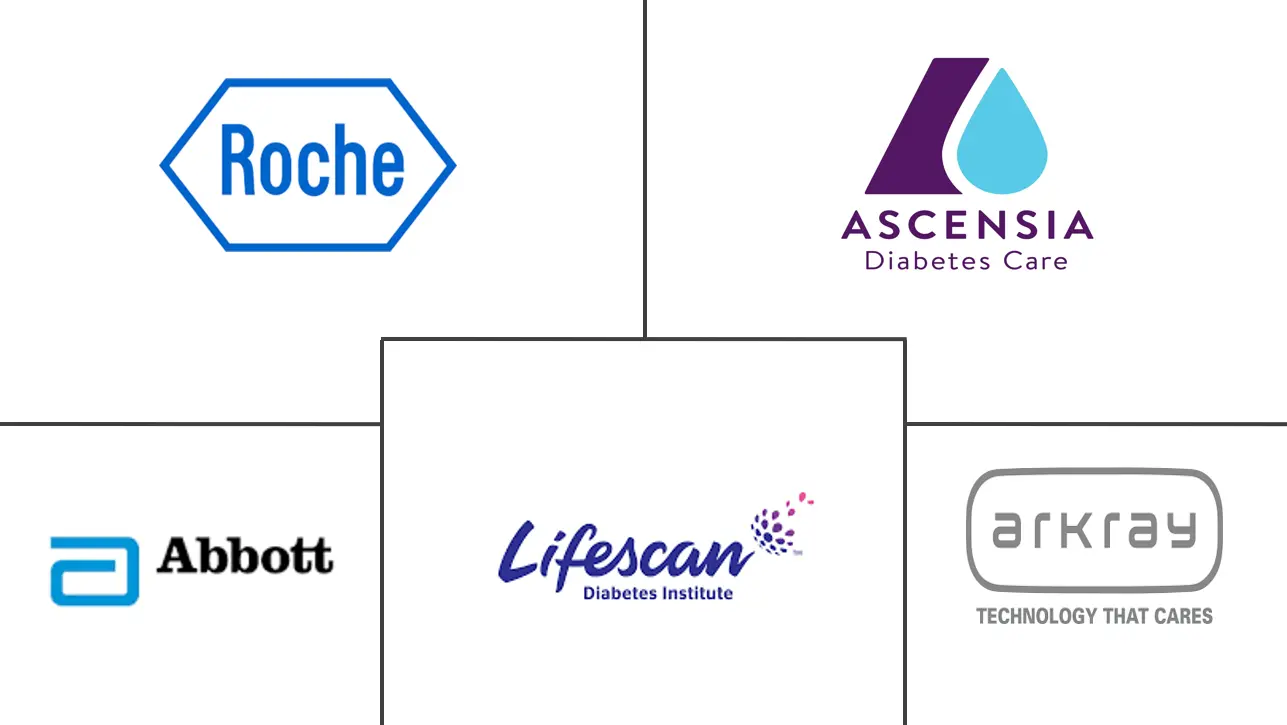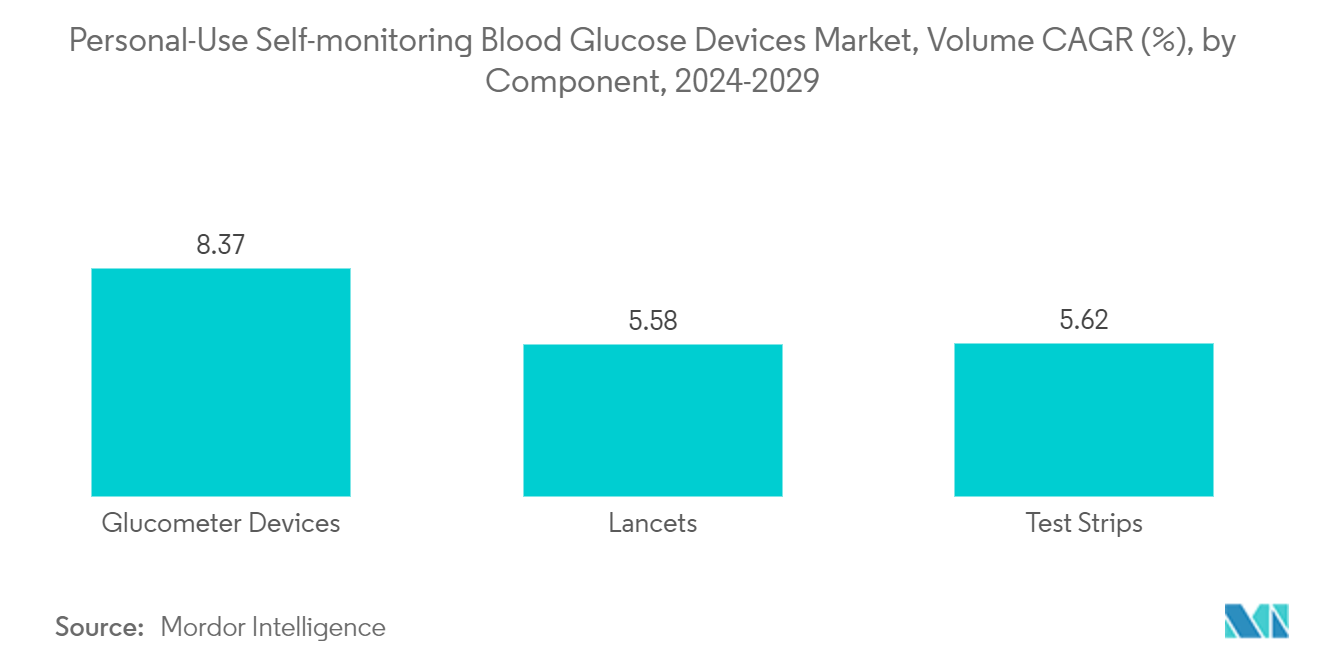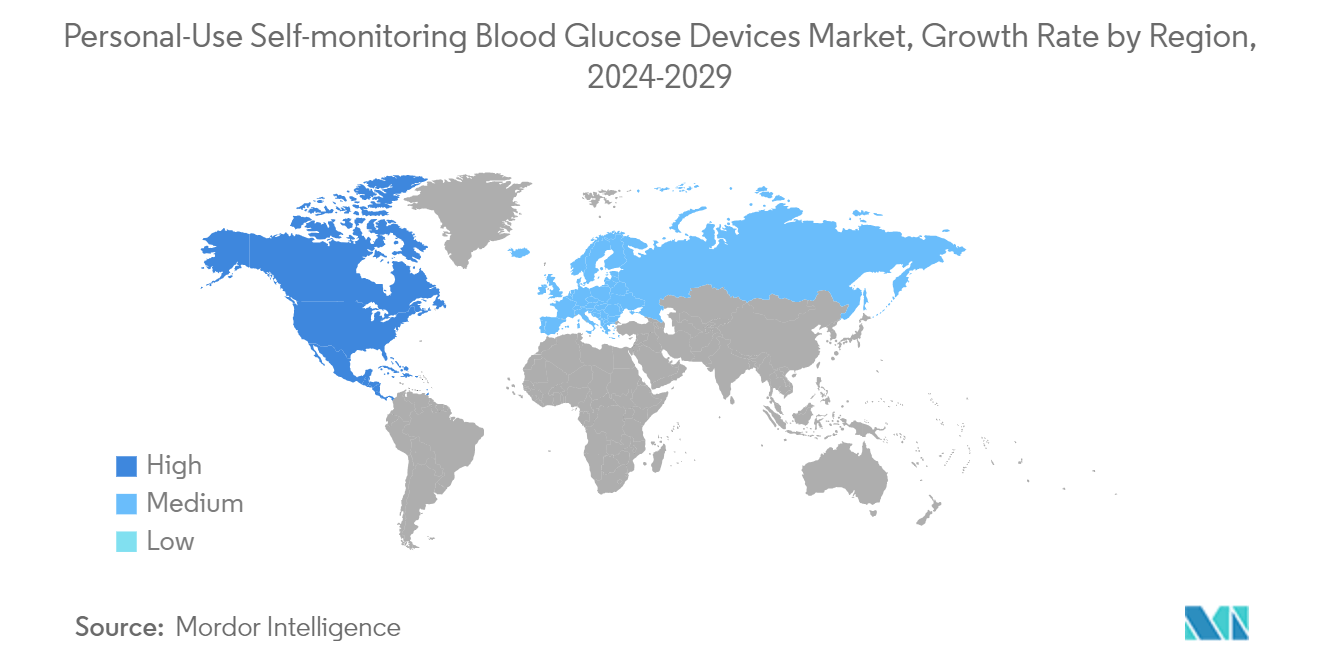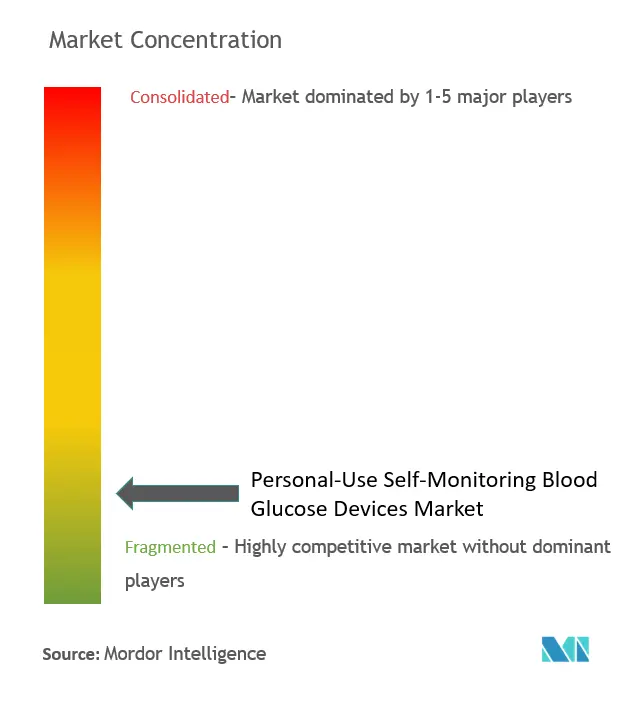Self-Monitoring Blood Glucose Devices Market Size

| Study Period | 2018 - 2029 |
| Market Size (2024) | USD 7.22 Billion |
| Market Size (2029) | USD 9.77 Billion |
| CAGR (2024 - 2029) | 6.23 % |
| Fastest Growing Market | North America |
| Largest Market | North America |
Major Players
*Disclaimer: Major Players sorted in no particular order |
Self-Monitoring Blood Glucose Devices Market Analysis
The Personal-Use Self-monitoring Blood Glucose Devices Market size is estimated at USD 7.22 billion in 2024, and is expected to reach USD 9.77 billion by 2029, growing at a CAGR of 6.23% during the forecast period (2024-2029).
The global rise in diabetes cases is leading to an increased need for self-monitoring blood glucose (SMBG) devices. Due to advancements in technology and a greater emphasis on managing diabetes, the SMBG devices market is expected to experience significant growth in the foreseeable future. This piece delves into the reasons behind this growth and provides insights into the future prospects of SMBG devices.
The pandemic also highlighted opportunities for continuing and expanding innovations in the delivery of diabetes care, through virtual consultations between healthcare providers and people with diabetes, and the use of diabetes technology. Crisis management has created unprecedented interest in remote care from both patients and providers and removed many long-standing regulatory barriers.
The rate of newly diagnosed Type 1 and Type 2 diabetes cases is seen to increase, mainly due to obesity, unhealthy diet, and physical inactivity. The rapidly increasing incidence and prevalence of diabetic patients and healthcare expenditure in developed countries are indications of the increasing usage of diabetic care products. Leading manufacturers are focusing on technological innovations and developing advanced products to gain a substantial market share.
Therefore, owing to the aforementioned factors the studied market is anticipated to witness growth over the analysis period.
Self-Monitoring Blood Glucose Devices Market Trends
The glucometer devices segment is expected to register the highest CAGR over the forecast period
The meters segment is expected to account for the highest CAGR of about 8.2% over the forecast period owing to the increasing adoption of glucometers in home care settings, the growing preference for home-based self-monitoring, and recent product launches of advanced glucometers.
Glucometers are simple, portable, and convenient blood sugar monitoring devices that are used for point-of-care management. A drop of blood from the patient's finger is dropped onto a paper test strip, which is impregnated with a glucose-specific enzyme that reacts with the glucose in the blood. The strip is inserted into the blood glucose meter and is read using either reflectance photometry or electrochemical technology to determine the glucose level in the blood. These monitors are also used to monitor blood glucose levels in clinical settings. In general, portable glucose devices have improved in precision and accuracy with each generation.
Self-monitoring blood glucose devices are garnering widespread adoption due to the availability of reimbursement options for glucose meters. Glucose meter devices must be replaced within six to eight months and are expensive. As a result, most people prefer health insurance plans that cover most of their total expenditure on healthcare devices. Such schemes cover the costs of diabetes testing supplies, test strips, and blood glucose meters. For example, Medicare, the federal health insurance program in the United States, covers approximately 80% of the cost of BGM devices for diabetic people.
The market players are adopting various strategies such as collaborations, partnerships, mergers, acquisitions, and expansions to increase market share. For instance, in May 2021, Roche Diabetes Care Canada announced a collaboration with Ellerca Health, a Toronto-based company dedicated to improving patient care through innovation and technology. The partnership included the launch of Accu-Chek and 360Care, combining Roche's Accu-Chek Guide blood glucose meter, customized home delivery of testing strips, and Ellerca's self-management digital program, 360Care, which empowers patients to be in control of their treatment schedule with access to a team of health coaches.
Thus, owing to the above-mentioned factors, the market is expected to grow over the forecast period.

North America is expected to dominate the Personal-Use Self-monitoring Blood Glucose Devices Market over the forecast period
The North American region is expected to register the highest CAGR of about 6.5% in the personal-use self-monitoring blood glucose devices market over the forecast period.
In the North American region, the prevalence of diabetes has increased dramatically during the last two decades, a fact driven by the increased prevalence of obesity and lifestyle changes owing to less physical activity, unhealthy food habits, and other lifestyle factors. The American Diabetes Association (ADA), the Endocrine Society, the American College of Physicians, the American Academy of Pediatrics, the Society of General Internal Medicine, and the National Academy of Medicine published statements and issued calls to action to address social determinants of health at the individual, organizational, and policy levels. In 2021, the ADA also published a scientific review describing the associations between SDOH and diabetes risk and outcomes, focusing on socioeconomic status, health literacy, the food environment, food insecurity, and neighborhood and physical environments, among other topics.
The Centers for Disease Control and Prevention's National Diabetes Statistics Report 2022 estimated that more than 130 million adults are living with diabetes or prediabetes in the United States. Type-2 diabetes is more common, and diabetes is more consequential among communities of color, those who live in rural areas, and those with less education, lower incomes, and lower health literacy.
In the United States, there are several innovations in diabetes management platforms by startups, like Glooko, OneDrop, Verily, Vacate, Insulet, Noom, Bigfoot Biomedical, Virta Health, Diabeloop, and Orgenesis, that have launched in the market. The growing awareness among people regarding advanced diabetes devices is improving the adaptability of PoCT glucose testing devices. Leading manufacturers are focusing on technological innovations and developing advanced products to gain a substantial market share.
Therefore, the studied market is anticipated to witness growth over the analysis period due to rising prevalence and the aforementioned factors.

Self-Monitoring Blood Glucose Devices Industry Overview
The personal-use self-monitoring blood glucose device market is fragmented, with manufacturers having a global market presence and occupying a major share like Abbott, LifeScan, Roche, Ascensia, etc., while the remaining are other local or region-specific manufacturers.
Self-Monitoring Blood Glucose Devices Market Leaders
-
Roche Diabetes Care
-
Ascensia Diabetes Care
-
Abbott Diabetes Care
-
LifeScan Inc.
-
Arkray Inc.
*Disclaimer: Major Players sorted in no particular order

Self-Monitoring Blood Glucose Devices Market News
- April 2023: NHS england relased recommendations for commissioning after the national evaluation of blood glucose meters, testing strips, and lancets.
- June 2022: LifeScan announced that the peer-reviewed journal Diabetes Technology and Therapeutics (DTT) has published Real World Evidence of Improved Glycemic Control in People with Diabetes. Using a Bluetooth-connected blood glucose meter with a mobile diabetes management application using the OneTouch Reveal mobile app with the OneTouch Verio Reflect meter, synced via Bluetooth wireless technology, could support improved glycemic control for people with diabetes.
Self-Monitoring Blood Glucose Devices Market Report - Table of Contents
1. INTRODUCTION
- 1.1 Study Assumptions and Market Definition
- 1.2 Scope of the Study
2. RESEARCH METHODOLOGY
3. EXECUTIVE SUMMARY
4. MARKET DYNAMICS
- 4.1 Market Overview
- 4.2 Market Drivers
- 4.3 Market Restraints
-
4.4 Porter's Five Forces Analysis
- 4.4.1 Bargaining Power of Suppliers
- 4.4.2 Bargaining Power of Consumers
- 4.4.3 Threat of New Entrants
- 4.4.4 Threat of Substitute Products and Services
- 4.4.5 Intensity of Competitive Rivalry
5. MARKET SEGMENTATION
-
5.1 Component
- 5.1.1 Glucometer Devices
- 5.1.2 Test Strips
- 5.1.3 Lancets
-
5.2 Geography
- 5.2.1 North America
- 5.2.1.1 United States
- 5.2.1.2 Canada
- 5.2.1.3 Rest of North America
- 5.2.2 Europe
- 5.2.2.1 Germany
- 5.2.2.2 Spain
- 5.2.2.3 Italy
- 5.2.2.4 France
- 5.2.2.5 United Kingdom
- 5.2.2.6 Russia
- 5.2.2.7 Rest of Europe
- 5.2.3 Asia-Pacific
- 5.2.3.1 Japan
- 5.2.3.2 China
- 5.2.3.3 Australia
- 5.2.3.4 India
- 5.2.3.5 South Korea
- 5.2.3.6 Malaysia
- 5.2.3.7 Indonesia
- 5.2.3.8 Thailand
- 5.2.3.9 Philippines
- 5.2.3.10 Vietnam
- 5.2.3.11 Rest of Asia-Pacific
- 5.2.4 Latin America
- 5.2.4.1 Brazil
- 5.2.4.2 Mexico
- 5.2.4.3 Rest of Latin America
- 5.2.5 Middle East and Africa
- 5.2.5.1 South Africa
- 5.2.5.2 Saudi Arabia
- 5.2.5.3 Oman
- 5.2.5.4 Egypt
- 5.2.5.5 Iran
- 5.2.5.6 Rest of Middle East and Africa
6. MARKET INDICATORS
- 6.1 Type-1 and Type-2 Diabetes Population
7. COMPETITIVE LANDSCAPE
-
7.1 Company Profiles
- 7.1.1 Abbott Diabetes Care
- 7.1.2 Roche Diabetes Care
- 7.1.3 LifeScan
- 7.1.4 Arkray
- 7.1.5 Ascensia Diabetes Care
- 7.1.6 Agamatrix
- 7.1.7 Bionime Corporation
- 7.1.8 Acon
- 7.1.9 Medisana
- 7.1.10 Rossmax International
- *List Not Exhaustive
- 7.2 Company Share Analysis
8. MARKET OPPORTUNITIES AND FUTURE TRENDS
** Subject To AvailablitySelf-Monitoring Blood Glucose Devices Industry Segmentation
Self-monitoring of blood glucose is an approach used by diabetic patients to measure their blood sugar level themselves using a glucometer, test strips, and lancets. Based on the readings, patients can adjust or check the effect of their treatment. The self-monitoring blood glucose device market is segmented into components and geography. The report offers the value (in USD) and volume (in units) for the above segments.
| Component | Glucometer Devices | |
| Test Strips | ||
| Lancets | ||
| Geography | North America | United States |
| Canada | ||
| Rest of North America | ||
| Geography | Europe | Germany |
| Spain | ||
| Italy | ||
| France | ||
| United Kingdom | ||
| Russia | ||
| Rest of Europe | ||
| Geography | Asia-Pacific | Japan |
| China | ||
| Australia | ||
| India | ||
| South Korea | ||
| Malaysia | ||
| Indonesia | ||
| Thailand | ||
| Philippines | ||
| Vietnam | ||
| Rest of Asia-Pacific | ||
| Geography | Latin America | Brazil |
| Mexico | ||
| Rest of Latin America | ||
| Geography | Middle East and Africa | South Africa |
| Saudi Arabia | ||
| Oman | ||
| Egypt | ||
| Iran | ||
| Rest of Middle East and Africa |
Self-Monitoring Blood Glucose Devices Market Research FAQs
How big is the Personal-Use Self-monitoring Blood Glucose Devices Market?
The Personal-Use Self-monitoring Blood Glucose Devices Market size is expected to reach USD 7.22 billion in 2024 and grow at a CAGR of 6.23% to reach USD 9.77 billion by 2029.
What is the current Personal-Use Self-monitoring Blood Glucose Devices Market size?
In 2024, the Personal-Use Self-monitoring Blood Glucose Devices Market size is expected to reach USD 7.22 billion.
Who are the key players in Personal-Use Self-monitoring Blood Glucose Devices Market?
Roche Diabetes Care, Ascensia Diabetes Care, Abbott Diabetes Care, LifeScan Inc. and Arkray Inc. are the major companies operating in the Personal-Use Self-monitoring Blood Glucose Devices Market.
Which is the fastest growing region in Personal-Use Self-monitoring Blood Glucose Devices Market?
North America is estimated to grow at the highest CAGR over the forecast period (2024-2029).
Which region has the biggest share in Personal-Use Self-monitoring Blood Glucose Devices Market?
In 2024, the North America accounts for the largest market share in Personal-Use Self-monitoring Blood Glucose Devices Market.
What years does this Personal-Use Self-monitoring Blood Glucose Devices Market cover, and what was the market size in 2023?
In 2023, the Personal-Use Self-monitoring Blood Glucose Devices Market size was estimated at USD 6.77 billion. The report covers the Personal-Use Self-monitoring Blood Glucose Devices Market historical market size for years: 2018, 2019, 2020, 2021, 2022 and 2023. The report also forecasts the Personal-Use Self-monitoring Blood Glucose Devices Market size for years: 2024, 2025, 2026, 2027, 2028 and 2029.
Self-Monitoring Blood Glucose Devices Industry Report
Statistics for the 2024 Self-Monitoring Blood Glucose Devices market share, size and revenue growth rate, created by Mordor Intelligence™ Industry Reports. Self-Monitoring Blood Glucose Devices analysis includes a market forecast outlook to 2029 and historical overview. Get a sample of this industry analysis as a free report PDF download.



